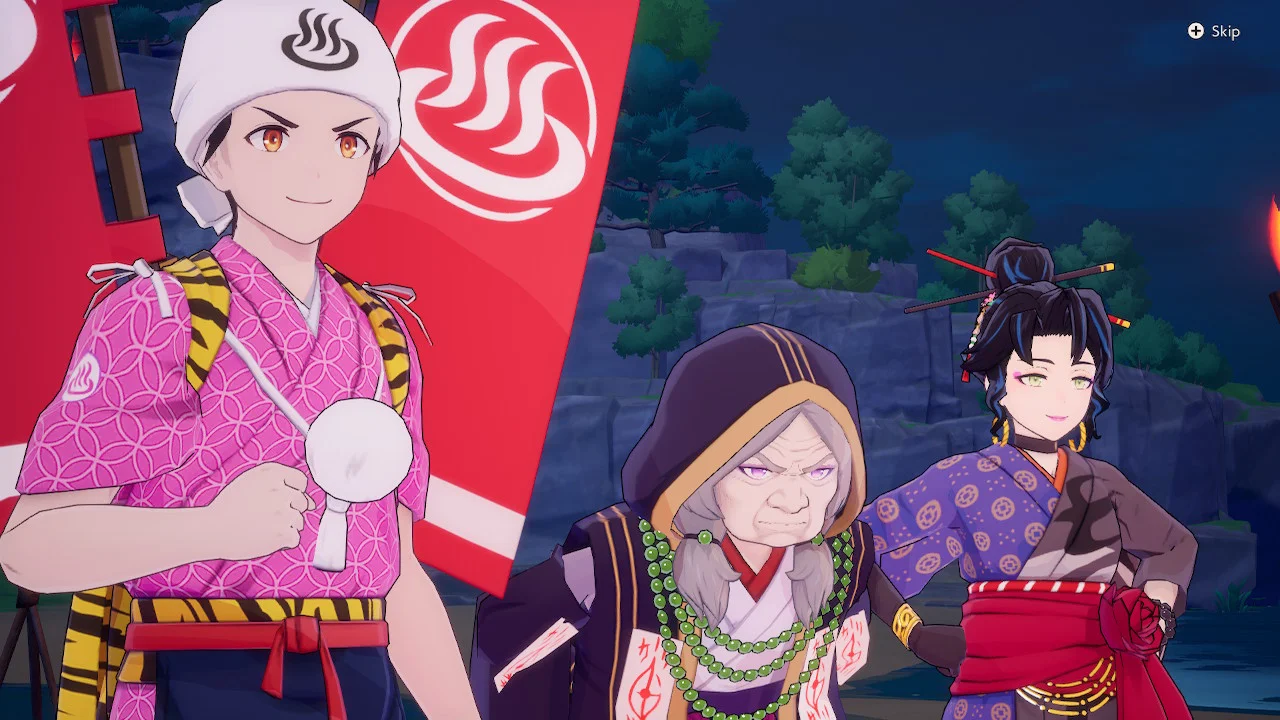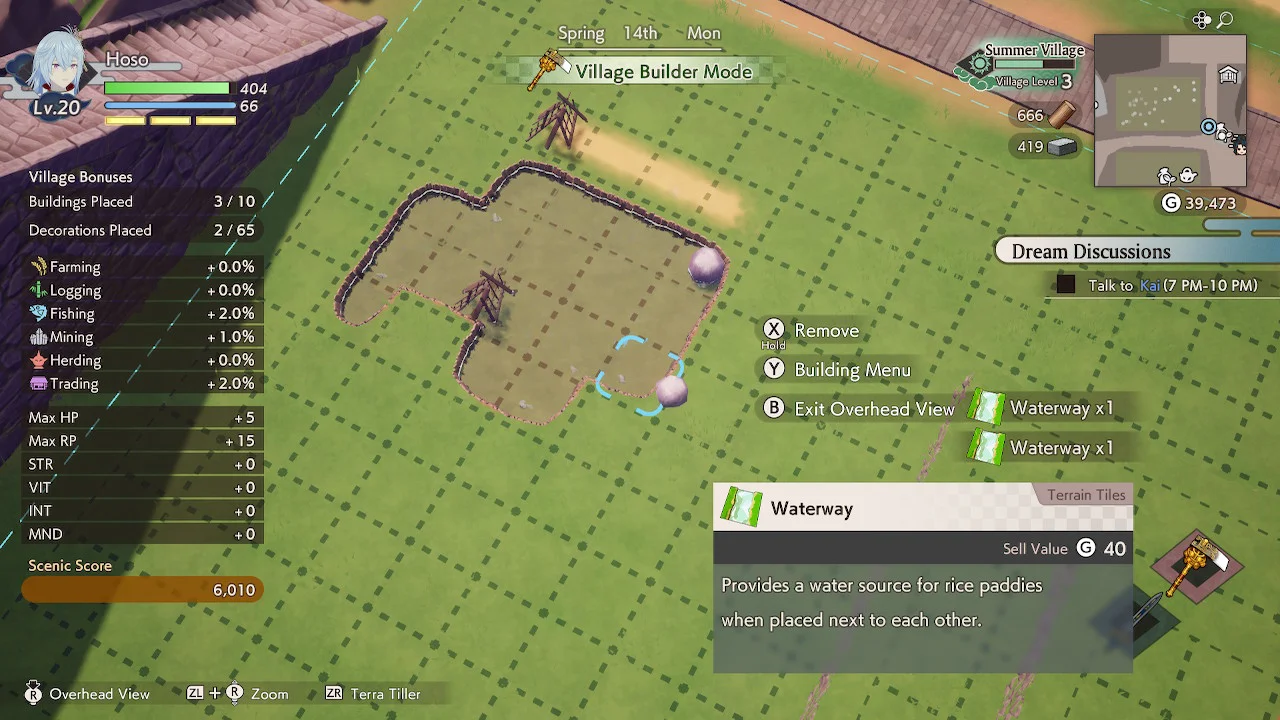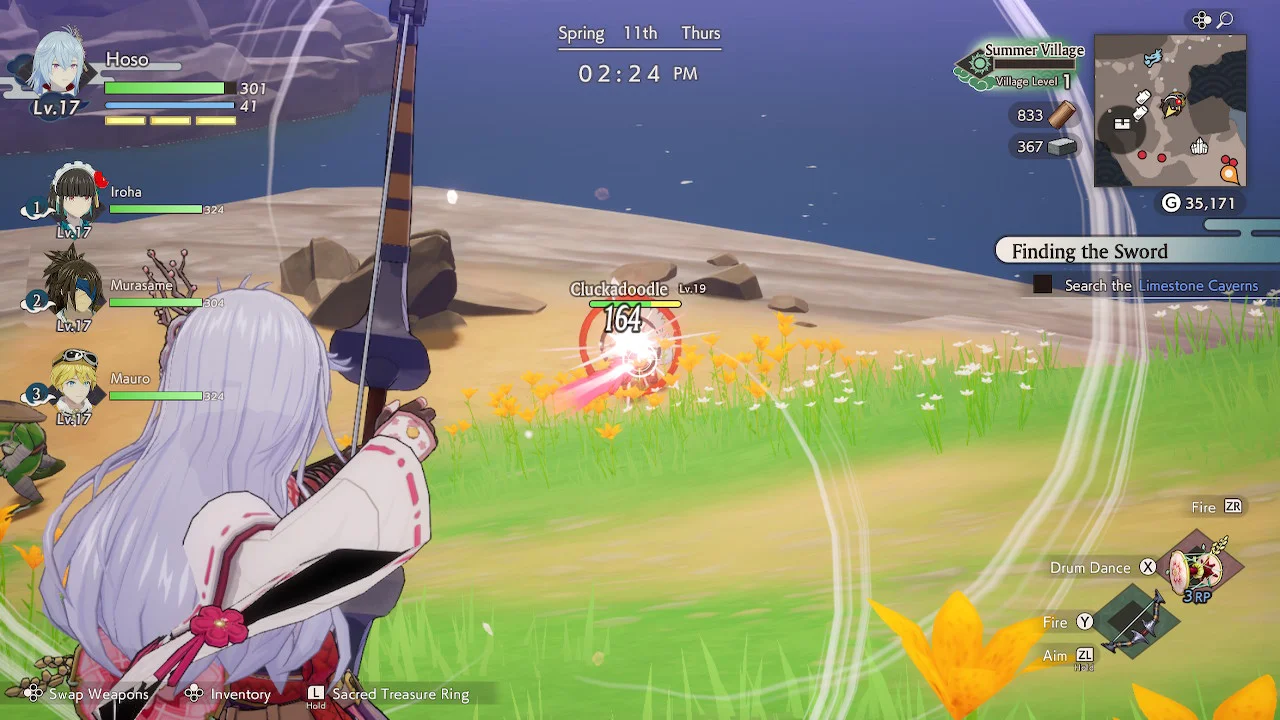Rune Factory: Guardians of Azuma isn’t “Rune Factory 6,” nor is it even the sixth Rune Factory game thanks to the similarly unnumbered Rune Factory Frontier and Tides of Destiny. Without the heavy mantle of a numbered title to weigh it down, Guardians of Azuma is free to be less strict with its approach to Rune Factory tropes and traditions. Although the game doesn’t disregard its roots entirely, this RPG-plus-farming game takes some fresh new steps forward and emerges as the strongest title in the series, complete with features that make it a game with longevity, worth coming back to again and again.
With a single glance, it’s clear how Guardians of Azuma begins to deviate from its Rune Factory predecessors: the game is deeply inspired by traditional Japanese culture and landscapes as opposed to the “generic Western fantasy” approach that the series typically leans into. But some of the game’s unique attributes aren’t noticeable immediately. The Rune Factory series is notorious for having levels for everything. You gain levels for each weapon type, cooking, mixing potions, and even activities like walking and sleeping. Some of these have clear benefits as they increase, such as learning new combat moves or being able to cook better recipes. The benefits to some others, like sleep, are less clear.
Guardians of Azuma foregoes these separate levels in favor of skill trees into which you can invest your experience. While your character still has an overall level, you also gain specific experience as you do things to use in associated skill trees. For instance, cooking earns you experience to use in the cooking skill tree, which includes cooking-specific passives, like the chance to raise your cooked dish’s level, and overall stat increases. Actions like walking and sleeping at a normal hour give generic experience you can use in any skill tree.
This system opens extra avenues for player expression—a must in a simulation hybrid like Rune Factory—as it gives you more control over how you shape your character’s abilities and stats. It’s also more sensible than Rune Factory’s old “oops all levels” system in which you might not know what certain levels influence. The clarity and customization capabilities of Guardians of Azuma’s skill tree system are a welcome alteration to a classic Rune Factory feature that better aligns with the player-centric values of both a simulation game and an RPG.
Gaining experience with your weapons is as simple as using them in battle, and combat is slightly better than in past Rune Factory titles. It’s still mostly picking the weapon with your favorite basic combo and then alternating between button mashing to deal damage and dodging to avoid taking damage. But you can swap to a secondary weapon on the fly, which doesn’t sound too special until you factor in the new bow weapons. You can use bows in Guardians of Azuma in the usual button-mash-combo manner, but you can also take aim for more precise and powerful shots. You can even land headshots or hit other enemy weak points to do more damage.
The biggest appeal of the bow is that if you set it as your secondary weapon, you can draw it for an aimed shot without swapping it into your primary weapon slot. If a boss is readying an AOE attack right beside itself, you can hop away to safety and still strike it without changing your weapons. Interweaving marksmanship between sword slices or magical talisman strikes adds a much-needed layer of complexity to the Rune Factory battle system. It’s still on the simple side, but can lead to interesting strategies such as sniping distant enemies or letting your party members draw a boss’s attention while you attack from afar.
You can also interweave powerful elemental strikes from special season-themed weapons called Sacred Treasures. Using these weapons costs Rune Points (the Rune Factory version of Mana or MP), but they deal massive damage, especially if you maintain their skill tree. While Sacred Treasures can offer an easy out when you’re up against powerful enemies, they really shine outside of battle. Like Rune Factory 5, Guardians of Azuma focuses on extensive exploration in vast environments. The titular lands of Azuma are plagued by blight that you must remove by using the Sacred Treasures. While clearing blight is part of the process of “100%-ing” the game and can open access to new areas or unlock special tree seeds for your farm, this is just the tip of the iceberg of Guardians of Azuma’s discoverable content.
The four main floating islands of Azuma each represent one of the seasons with Japanese influence in both the flora and their architecture, such as the Spring Village brimming with pretty pink sakura trees, and the Autumn Village painted all manner of reds, yellows, and oranges by the Japanese maples and ginkgo trees. There’s a clear love for what each season and nature itself has to offer in the context of Japan, helping Guardians of Azuma’s setting not only stand out among its Rune Factory peers, but make a genuine impact when you play. Looking past the lovely visuals, each major island features a village and a large explorable area where you can forage for herbs and mushrooms, chop lumber and mine ores, and battle and eventually tame monsters. You can also explore many smaller islands with similar discoveries to find. Extra hidden goodies include frog statues that gift you with various recipes when you find them, Jizo statues you can tidy up, and hidden targets you need to shoot with your bow and arrows. Each of these “Azuma Quests” offer rewards that increase the already strong appeal of exploring every nook and cranny of Azuma.
When you return to the homefront after a long day of battling and exploring, you’re met with Guardians of Azuma’simpressive cast. Relationship-building has always been a key element of Rune Factory, and Guardians of Azuma includes 25 characters you can befriend and, in some cases, romance, plus a few extra side characters for good measure. Guardians of Azuma continues the series tradition of bringing back a prior game’s character—in this case, Hina from Rune Factory 5. But the rest of the characters are new and together form the best crew in the series thanks to the changes Guardians of Azuma makes to the relationship-building process.

Raising a character’s Bond Level is more nuanced and engaging in Guardians of Azuma compared to past Rune Factory games. While you always have the option to mildly improve your relationship with a character with a quick chat, “hanging out” with them is where the real progress is. Hanging out lets you pick between four options, with more added as you fill out your “Social Activities” skill tree. One option will always be to “give a gift,” the classic method of improving your relationship with a video game character. The other three options can range from chatting about specific topics, visiting special locations, or even going window-shopping. The special options you unlock from the skill tree are even more involved, such as sharing a parasol on a rainy day or poking their cheek. Each character has activities they like and dislike, which further fleshes them out and makes befriending them feel more genuine than just giving them presents until they like you.
Once you get the game’s eligible bachelors and bachelorettes to a high enough Bond Level, you can start learning about their interesting personal conflicts in their fully voiced Bonding Quests. Guardians of Azuma features an all-star voice cast in both English and Japanese, and the phenomenal work of actors such as Yuki Kaji, Junichi Suwabe, Soma Saito, and Fairouz Ai helps elevate Bonding Quests and improve the overall soundscape of the game. These sub-stories naturally focus on the target character, but also get other NPCs involved in the shenanigans. The end result leaves the cast feeling interconnected rather than like a bunch of characters who only have time to spare for the protagonist. Progressing in some of these Bonding Quests also requires reaching a specific point in the main story because they reference an event from it. This weaves the characters firmly into Guardians of Azuma’s world rather than leaving their sub-stories feeling detached from what’s around them.
Guardians of Azuma’s cast also isn’t detached from its audience. Prior Rune Factory games are no stranger to character trip-ups. Some games had no female protagonist option and thus no bachelors, leaving the cast feeling unbalanced—and a major chunk of the games’ audience feeling unrepresented. Others had a character or characters who felt inappropriately immature to be a love interest. By comparison, Guardians of Azuma has a diverse cast of love interests who not only feel suitable as marriage candidates but are all intriguing in their own ways.
The game’s side characters are also charming, and while they don’t get full-blown sub-stories, Guardians of Azuma offers more reasons than ever to befriend them. Each Bond Level provides rewards, from the character giving you birthday gifts to unlocking the option to share dinner with them. At level 6, you can cook with them, which comes with a cute animation and the option to make a special dish brimming with the helper character’s personality. Collecting cooking recipes is already one of many large draws for the collector or completionist player—adding specialty dishes to the mix makes it even more compelling to increase each villager’s Bond Level.

Befriending an NPC also opens up the option to add them to your party, and you can fight alongside up to three other party members at a time. This allows you to make a more balanced, “traditional” RPG-style party rather than just pairing off with one other character and a tamed monster—although you can still add your monsters to your party if you’re so inclined. The NPCs may also chat with each other while you’re all out together, providing more opportunities to gain relationship points with them and get to know them better.
The way characters converse feels organic and unique, even if the “party chats” can sometimes be repetitive. Thankfully, there’s an option to tweak the frequency of these discussions to your liking. It’s best to keep them on in some capacity, though, because it’s amusing to hear their interactions, such as the bickering between the game-loving god Kurama and the sore loser Kai, or fellow Winter Village residents thanking their local deity Fubuki. Even in the throes of battle, Guardians of Azuma’s characters get the opportunity to show just how distinct and lovable they are. It’s difficult to dislike any of them.
If anything, Guardians of Azuma follows in the time-honored Rune Factory tradition of having cast members who are so great in terms of both writing and design that it’s a crime they aren’t marriage candidates. Two of Guardians of Azuma’s biggest offenders, Cuilang and Pilika, will be made into marriage candidates through DLC, which would normally be a questionable bandage over the problem. But a standard save file still features a whopping 13 love interests without the DLC, granting Guardians of Azuma the honor of having the highest number of romance candidates in any Rune Factory game yet. And Guardians of Azuma retains same-gender marriage, which was first implemented into the series with Rune Factory 5, giving players the widest range of characters to get to know and fall for.
Besides relationships, the other major simulation aspect in Rune Factory is farming, and Guardians of Azuma makes the experience enjoyable and offers as much opportunity for player expression as is reasonable. Building zones let you freely place fields for planting crops, shops that generic villagers can run, and all manner of decorations. One of the most important features in a game with freely customizable building zones is how easy it is to move your belongings around once new zones open up, old ones grow in size, or you gain access to new items that change your layout plans. You’ll have to place certain buildings and farming fields out of necessity at the start, but as you gain access to more zones, you will likely want to take a more creative approach to your urban planning.

Guardians of Azuma makes this process delightfully easy thanks to numerous features within its builder mode. While it’s understandable to wait until your crops are ready to harvest before re-organizing your fields, removing a field or even a tree refunds you the appropriate seeds. Just find a new spot for them and drop the seeds back into the earth, and they will start their growth process over. However, if you keep your trees or large landmarks like buildings within the same zone, you can simply “move” the object, keeping trees at the same growth stage and villagers assigned to their stores. If you absolutely must pocket a building to transport elsewhere, you must reassign a shopkeeper in the villager menu once you’re done. But this minor inconvenience can’t dream of detracting from this system’s flexibility, offering lots of room for personal expression as players design their villages. But none of these are the greatest feature of builder mode: that honor goes to the top-down view.
Pressing in the right stick while in builder mode activates the top-down view, where you can move things about with the precision of a grid that the standard third-person method generally lacks. You can even make large, sweeping changes with the press and hold of a button. Pressing A over a crop will either plant it, if you have the seeds equipped, or water or harvest it depending on its stage of growth. Holding A will keep that action active, so you can direct the cursor with the control stick and plant, water, or harvest as many crops as possible in one fell swoop. The same goes for removing buildings and decorations, allowing you to make major changes quickly. It also helps clear debris quickly when you first gain access to new zones. This quality of life feature makes for the easiest, most convenient farming and building in the history of Rune Factory, even including its sister series Story of Seasons.
Of course, you can always farm the traditional way, which can sometimes be in your favor. Watering in top-down or builder mode means in-game time doesn’t pass, but you can use your Sacred Treasures when you’re outside of that mode. For instance, you can water an approximately 4-by-4 grid of farmland at once with a single flick of the parasol, and the fan harvests many crops down a line. Chopping down fully-grown crops with the blade has the more obvious benefit of giving you extra seeds with the rare chance of them being one level higher than their crop. But regardless of which Sacred Treasure you use, you’ll always gain experience for its skill tree, so you may want to take the opportunity to do some traditional farming from time to time, even if the builder mode’s top-down view is a great leap forward for player expression in Guardians of Azuma.
There is so much to love about Rune Factory: Guardians of Azuma, from its improvements to farming to its lovable cast and how its story calls back to previous Rune Factory plot elements. The game clearly loves its heritage just as much as it loves Japan, so it’s easy to love it back. Guardians of Azuma is by far the greatest Rune Factory game yet, thanks to its forward strides in farming and player expression. And while there are still some minor limitations to overcome, Rune Factory 6 has some massive shoes to fill. The best simulation games keep you coming back to maintain your personalized worlds, and Guardians of Azuma does just that, with flying colors of all the seasons.



